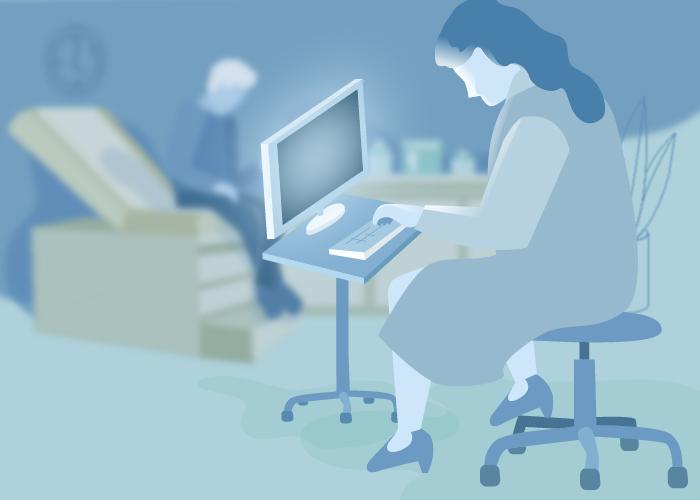Wellness programs for health care workers emphasize self-care; they’re overlooking a huge contributor to burnout: Patient records

Credit: Shannon Alexander/University of Florida
Judges don’t do court stenography. CEOs don’t take minutes at meetings. So why do we expect doctors and other health care providers to spend hours recording notes — something experts know contributes to burnout?
“Having them do so much clerical work doesn’t make sense,” said Lisa Merlo, Ph.D., an associate professor of psychiatry and director of wellness programs at the University of Florida College of Medicine. “In order to improve the health care experience for everyone, we need to help them focus more on the actual practice of medicine.”
Physician burnout affects patients, too. Stressed doctors are less compassionate and more likely to make mistakes. Clinicians who leave the field or cut back hours reduce patient access to care, and replacing doctors in the midst of a physician shortage drives up costs.
“We can’t ignore burnout and expect doctors to just keep picking up the slack,” Merlo said.
Electronic health records — or EHRs — have enabled better, faster and more accurate communication among health care providers. But the time required to populate them can mean less interaction with patients and more time after hours typing notes, which can be more driven by insurance requirements than usefulness in patient care.
To find solutions, Merlo teamed up with Oliver Nguyen, a research coordinator and IT specialist in the College of Medicine, to evaluate 35 studies of records-related burnout, looking for common threads. Their study, published in the Journal of the American Medical Informatics Association, is part of a special issue on physician burnout.
“The longer clinicians spend on records, especially after hours or on weekends, the more it’s associated with burnout,” Nguyen said.
As the pandemic stretches health care workers ever thinner, “we’re beyond the straw that broke the camel’s back,” Merlo said. “The system has survived for so long because physicians step up and get the work done out of a sense of altruism and dedication to their patients. But there’s only so long you can sustain that.”
Physician wellness initiatives have increased during the pandemic, often focusing exclusively on self care. But “adding more yoga classes is not going to address a clinician working on electronic health records at home at 11 p.m.,” Merlo said.
Streamlining record-keeping could help. So when Nguyen approached Merlo about optimizing electronic records, she was eager to collaborate. With colleagues at the University of Alabama at Birmingham, the U.S. Navy, Moffitt Cancer Center, the University of South Florida and the University of Central Florida, they uncovered several potential solutions that could help physicians. (Another study looked at nurse burnout; future research will include other health care providers.)
Their recommendations:
- Share the load
Overflowing inboxes contribute to burnout. As the pandemic shifts some office visits to videoconference, email and phone communication, “inboxes are blowing up,” Nguyen said. A shared inbox that allows office staff to triage messages that don’t require a doctor’s input, such as insurance questions, can help.
Revisit policy
The Centers for Medicare and Medicaid Services launched the Patients over Paperwork initiative in part to reduce the documentation requirements. If it shows promising results for reducing records burden, Nguyen and Merlo say, it could serve as a model for private insurers to emulate.
Create power users
Even when they’re familiar with an EHR interface, doctors might not know about time-saving features like templates and bookmarks. An optimization team that offers proactive support can streamline time spent in the system.
Collaborate on design
“Usability continues to be a struggle for physicians,” Nguyen said. More input from users can help when it comes to designing EHRs, as well as selecting and implementing them.
“The good news is, a lot of the issues can be fixed,” Merlo said. “If we invest in these resources, we can make this better for patients, for health care providers, for everybody.”
###
Media Contact
Alisson Clark
[email protected]
Original Source
https:/
Related Journal Article
http://dx.




